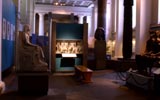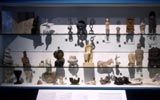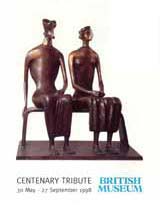| |
|
 |
 |
 |
 |
A Sense of Form - Henry Moore at the British Museum, 1998.
A centenary tribute - 30 May -27 September 1998.
Henry Moore's innovative approach to sculpture had its origins in his discovery of the British Museum's unique collections.
As a student at the Royal College of Art in 1921, he made regular visits and was very inspired by all he saw at the Museum,
sketching the forms that interested him. Throughout his long career, he continually acknowledged this influence..."nine tenths
of my understanding and learning about sculpture came from the British Museum". H.M.
In his final years, Henry Moore made another series of intensive tours of the British Museum, from which came the book,
Henry Moore at the British Museum (1981), where he wrote about his favourite sculptures. One work he greatly admired was
an Egyptian limestone pair statue that had influenced his King and Queen (1952-3). As part of his centenary tribute this
celebrated work was specially loaned from the Tate Gallery and sited as if in conversation with its ancient forebear in
the Egyptian Sculpture Gallery.
Moore had a unique ability to synthesize natural forms with ancient and ethnographical sculptures and kept a vast assortment
of objects in cabinets for inspiration in his studio and home. For this exhibition, a display case was specially installed
containing some Cycladic and Mexican sculptures from the British Museum together with a selection from Moore's own collection
of natural objects like pebbles, shells and bones along with his maquettes. Some of these plaster maquettes had never been
previously exhibited before outside of the Henry Moore Foundation and these hand-sized sculptural sketches reveal the intense
creative process from which many of his more familiar large public sculptures evolved.
The quality Moore most admired in what he saw at the British Museum was the sculptor's instinctive understanding of material.
The subtle contours and sharp edges of Cycladic figurines, the monumentality of Egyptian and Mexican sculpture, and the intense
vitality of the Ethnographic wooden carvings. While he found less affinity to the more representational character of Greek
sculpture, he became especially interested in the helmet form which led to a major group of works. Based on examples he
had seen in the Museum he also carved his own series of masks which were strongly Mexican in character. The collections also
helped him to identify a number of universal themes which allowed continuous experiment of sculptural form.
"...a comparison between a sculpture made nowadays and something made in 3000 BC ...might help to show that common fundamental
sculptural ideas persist ... Also it could suggest that the British Museum should not be looked on as a collection of dead art
disconnected from our own times." H.M.
1st picture from top:
Henry Moore's bronze sculpture, King and Queen, 1952-53, Tate Gallery [LH350] and Limestone pair statue of a high official and
his wife about 1300 BC, British Museum [EA36] installation Egyptian Sculpture gallery, 1998
2nd picture from top:
Display case installed in Egyptian Sculpture Gallery containing Moore's maquettes, his Notebook No.3, 1922-24 of studies of
Sculpture in the British Museum and collection of natural forms juxtaposed with Cycladic with Mexican antiquities from the
Museum's collection.
|
|
 |
 |
Henry Moore's bronze sculpture, King and Queen, 1952-53.
|
 |
 |
Display case installed in Egyptian Sculpture Gallery.
|
 |
 |
Detail of display case.
|
 |
 |
Exhibition guide.

|
 |
 |
|
|
|